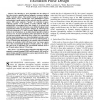Free Online Productivity Tools
i2Speak
i2Symbol
i2OCR
iTex2Img
iWeb2Print
iWeb2Shot
i2Type
iPdf2Split
iPdf2Merge
i2Bopomofo
i2Arabic
i2Style
i2Image
i2PDF
iLatex2Rtf
Sci2ools
TMI
2008
2008
Sparsity-Enforced Slice-Selective MRI RF Excitation Pulse Design
We introduce a novel algorithm for the design of fast slice-selective spatially-tailored magnetic resonance imaging (MRI) excitation pulses. This method, based on sparse approximation theory, uses a second-order cone optimization to place and modulate a small number of slice-selective sinc-like radio-frequency (RF) pulse segments ("spokes") in excitation -space, enforcing sparsity on the number of spokes allowed while simultaneously encouraging those that remain to be placed and modulated in a way that best forms a user-defined in-plane target magnetization. Pulses are designed to mitigate 1 inhomogeneity in a water phantom at 7 T and to produce highly-structured excitations in an oil phantom on an eight-channel parallel excitation system at 3 T. In each experiment, pulses generated by the sparsity-enforced method outperform those created via conventional Fourier-based techniques, e.g., when attempting to produce a uniform magnetization in the presence of severe 1 inhomogenei...
Second-order Cone Optimization | Sparse Approximation Theory | Spatially-tailored Magnetic Resonance | TMI 2008 |
| Added | 15 Dec 2010 |
| Updated | 15 Dec 2010 |
| Type | Journal |
| Year | 2008 |
| Where | TMI |
| Authors | Adam C. Zelinski, Lawrence L. Wald, K. Setsompop, Vivek K. Goyal, Elfar Adalsteinsson |
Comments (0)

